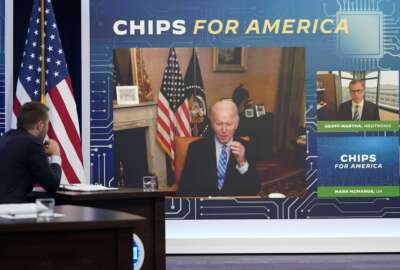
Hubbard Radio Washington DC, LLC. All rights reserved. This website is not intended for users located within the European Economic Area.
Hubbard Radio Washington DC, LLC. All rights reserved. This website is not intended for users located within the European Economic Area.
Last year's Chips Act was enacted to help the U.S. semiconductor industry. The law gave jobs to lots of federal agencies. Even the State Department.
Last year’s Chips Act was enacted to help the U.S. semiconductor industry. The law gave jobs to lots of federal agencies. Even the State Department. State received $100 million a year for five years to help secure the semiconductor manufacturing supply chain. To go deeper into this subject, The Federal Drive with Tom Temin spoke with Ramin Toloui, the Assistant Secretary for the Bureau of Economic and Business Affairs.
Interview transcript:
Tom Temin And you don’t often think of the State Department and industrial manufacturing types of topics. So what is the job of state under the CHIPS Act precisely?
Ramin Toloui Well, as you mentioned, this historic piece of bipartisan legislation from last year, the Chips and Science Act of 2022 is targeted at restoring America’s technological leadership through a renaissance in American high tech manufacturing. And the members of Congress, when they pass the CHIPS Act, recognize that achieving that objective relies upon strong global partnerships. These supply chains that we have for semiconductors are global supply chains, our international telecommunications systems are also global. And so Congress, when they pass the CHIPS act set aside $500 million for the purpose of deepening those international partnerships, and specifically they appropriated that money to the State Department through something called the International Technology Security and Innovation Fund. And so State will be implementing this fund as part of trying to realize the goals of the CHIPS act.
Tom Temin And this fund was not preexisting with other dollars. But this is also a new fund, then?
Ramin Toloui Correct. That’s a new fund created by the CHIPS act.
Tom Temin And what will the State Department specifically do here with it?
Ramin Toloui We have basically, two main lines of effort. The first line of effort is strengthening these global semiconductor supply chains. And in that line of effort, we’re looking to do four different things. The first thing is to help secure those critical raw materials that are necessary inputs to semiconductor manufacturing. Second, we’ll be looking to diversify what is called the downstream component. So after semiconductor chips are manufactured, they need to be prepared to put into the products that we use. And a lot of those activities we anticipate will not take place in the United States, but in other countries. In Asia, we hope, also in the Western Hemisphere. The third area of focus is to coordinate these policies related to semiconductors with our allies and partners. Last week, it was announced that the EU is proceeding with something, the European Union with something called the EU Chips Act. Other countries are taking efforts to support their own semiconductor manufacturing, and we want to make sure that these efforts are complementary and aligned with one another. And then the final area under semiconductor supply chains is protecting critical national security elements of these important technologies. In the second area, which is for secure IT systems or information technology and communications systems. We’re looking at three lines of effort. First of all, we’re looking to help other countries develop the capacity to govern their telecommunications systems and secure them. Second, we’re looking to try to find ways using the [United States Agency for International Development (USAID)], the U.S. Trade and Development Agency, the Ex-Im Bank, to try to support investment, to deploy these systems, deploy trustworthy telecommunications systems. And then finally, similar to global semiconductor supply chains, the third line of effort is going to be to defend against cyber risks from malicious actors. And so those are some of the activities that we’ll be doing with this fund.
Tom Temin Now, the supplies that we were talking about, there three basic semiconductor manufacturing supplies. There’s the substrate, there’s the chemicals that are deposed on that substrate, and then there’s the packaging to make it into a useful device. These are largely foreign sourced, and I’m surprised, I guess I would have thought Commerce Department would have been the lead here.
Ramin Toloui We’re working very closely with Commerce. As you know, the majority of the CHIPS Act funding, 50-billion-plus dollar appropriation goes to the Commerce Department, and they’re leading particularly domestic efforts to support U.S. manufacturing of semiconductors. And then in our foreign engagement, we’re partnering very closely with the Commerce Department, identifying the critical materials that are going to be important to U.S. industry, working with them on mapping various global sources, and also working with them to map the downstream elements, as you referred to the packaging, which is that process of preparing the silicon to put into these products. So this is something that we’re doing in close cooperation with the Commerce Department. But then, of course, deploying the established diplomatic lines of communication that the State Department has.
Tom Temin We are speaking with Ramin Toloui. He is assistant secretary of state for the Bureau of Economic and Business Affairs. And how does this map across the way the State Department is structured overseas? You’ve got the embassies and consuls. And generally, you talk to other people from the governments of those nations. How does industry get tied into this government- to-government kind of model that tends to dominate at state? That’s really your mission.
Ramin Toloui I think that the COVID pandemic illustrated just how important the collaboration with other governments, but also with the private sector is to the economic well-being of our citizens. So during COVID, we recognized how vulnerable these global supply chains are for critical goods like medical, personal protective equipment, other medical devices, even inputs to our auto sector. A lot of we’re disrupted by the challenges facing global supply chains, including in semiconductors. And so our missions overseas have established the habits of not only engaging with governments, but also with private businesses and the private sector. And I would say, those habits are also ones that have been a part of what we do here in the main state in Washington, D.C., in particular, my bureau for a long time. Were the Bureau of Economic and Business Affairs, and so we have the lead in the department for engaging with the private sector. As we roll out this ITSI Fund, the International Technology Security and Innovation Fund, our collaboration not only with our posts overseas, but with the private sector is going to be extremely important. Already, we’ve had a lot of engagement with industry groups in semiconductors, individual companies. When I’ve traveled to the West Coast, when I’ve traveled to Europe, Japan, Singapore, meetings with the private sector has always featured very prominently.
Tom Temin And is the government of that nation present when you have these meetings? I’m thinking of, say, suppose a certain mineral is required to make high end chips and it comes from Africa. When you go to an African nation, it’s not quite the same as going to a European Union nation. And you want to talk to a company, and who knows what the connections of that company are to that government. We can understand this in Europe and the United States, may be a little muddier in a place like certain African countries. What would happen? How would you initiate that? And what would the conversations look like?
Ramin Toloui Your question, Tom, really highlights why the State Department’s role is so important here. There is a lot of diversity as we look across the world on the relationship between government and business, government and natural resource management, government and the industrial manufacturing capacity. And so the answer really differs by different country. We’ve found that we’ve done engagements of various kinds, sometimes, and I would say in my experience, it’s typically been with government officials on the one hand and private sector officials on the other. But that’s not universally the case. And I think the key to our success, in this endeavor is recognizing the kind of engagement that’s most likely to generate the outcome we want, which is diverse, reliable, robust sources of the raw material inputs into semiconductor manufacturing. And then diverse and resilient downstream capacity for processing that silicon into the products that we use.
Tom Temin And the $100 million a year. 500 million, nice round number. It sounds a little arbitrary. How will that money be applied, actually? What do you need the money to do?
Ramin Toloui Well, there are a number of different lines of effort which I’ve described. So, for example, in the downstream processing capacity, and this goal of trying to diversify the various places in which that downstream processing of the silicon wafers, silicon chips can occur. One thing is we have examples of countries that have done this very successfully. And so we want to understand, well, what were the enabling conditions in those countries that enabled them to become leaders in that kind of packaging, testing and assembly. And once we can identify what are those attributes of the policy environment, we can help have a dialog with other countries that could be part of that supply chain, as part of diversifying the universe of countries that are able to do that processing. So that would be one example in this downstream component. On the policy dialog component, there is going to be the need to bring in certain types of expertise into the U.S. government in order to have those kinds of discussions. And so, as part of this CHIPS Act funding, we’re anticipating hiring 18 new experts at the State Department in order to conduct the analysis in the various types of lines of effort that I’ve described, both on the semiconductor supply chain side and on the secure information communications technology side. So those are some of the ways in which both programmatically and internally, we’ll be looking to deploy these funds.
Tom Temin And by the way, am I correct in assuming that the supply chain for United States chip manufacturing does encompass most of the continent, maybe not Antarctica.
Ramin Toloui Well, where these various minerals are is very, very diverse. And then the places where we hope that they can be processed is also something we want to increase the diversity of. So this is really a global effort. One principle that we are acting on is that achieving success of the CHIPS Act is not something that the United States can do on its own. It has to do in partnership with other countries to get the jobs, the manufacturing jobs that we want in the United States out of the CHIPS Act. To get that security of supply for U.S. consumers and businesses that we want out of the CHIPS Act, requires these international partnerships.
Copyright © 2024 Federal News Network. All rights reserved. This website is not intended for users located within the European Economic Area.
Tom Temin is host of the Federal Drive and has been providing insight on federal technology and management issues for more than 30 years.
Follow @tteminWFED


